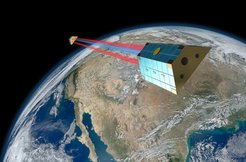Satellite gravimetry
Satellite gravimetry measures the Earth's gravitational field from low Earth orbit. GRACE Follow-On uses LISA technology to monitor critical indicators of climate change caused by changes in the Earth's gravitational field. The mission uses a laser interferometer with nanometre accuracy between two satellites. Because of their expertise, researchers at the AEI are involved in the design of the laser interferometers for future similar missions.
GRACE
GRACE (Gravity Recovery And Climate Experiment, 2002-2017), was a joint US-German satellite mission that has provided new and unexpected insights into the natural processes of the Earth. In the GRACE mission, the distance between two spacecraft was measured using a microwave ranging system. Temporal estimates of the Earth's gravity field are inferred from changes in this distance. The changes in Earth's gravity field in turn can be used to measure indicators of climate change – like melting polar ice or changes in groundwater levels.
GRACE Follow-On

The GRACE Follow-On mission (GRACE FO, 2018-today) reflies the identical GRACE spacecraft and instruments, but supplements the micrometre-level accuracy microwave measurement with a laser interferometer with nanometre-level accuracy.
The laser interferometer demonstrator on GRACE Follow-On is a partnership between NASA, which provides the laser, cavity assembly, and ranging processor, the GFZ Helmholtz Centre for Geosciences, and the Albert Einstein Institute, which is responsible for and overseeing the laser ranging instrument and in particular the measurement optics and steering mirror assembly along with instrument integration and testing.
The mission was successfully launched into Earth orbit on May 22, 2018. First observational data were received in the summer of 2018. Since then, the system has been running reliably and has been delivering high-precision distance measurements in scientific data taking mode.
LISA technology in an Earth orbit
For monitoring the Earth gravitational field LISA Pathfinder technology is employed: The LISA phasemeter was adapted to the needs of the gravity field mapping mission.
Under this project a consortium of U.S. and German institutions produced hardware for the laser ranging interferometer flying on the GRACE Follow-On mission. This system improved the inter-satellite ranging sensitivity by a factor of 200 over the initial GRACE mission.
Preparing the next-generation geodesy satellites
In the future, two orbiting satellite missions could measure the Earth's gravitational field and how it changes even more precisely. Because of their expertise, AEI researchers are involved in the design of the laser interferometers used in both projects.
GRACE-C
GRACE-C is a joint mission of the German Space Agency at the German Aerospace Center (DLR) and the US space agency NASA. The Max Planck Institute for Gravitational Physics (Albert Einstein Institute; AEI) in Hannover is involved in implementing the German contribution, the construction of the central laser-based measurement system, together with the GFZ Helmholtz Centre for Geosciences. The launch is scheduled for 2028.
NGGM and MAGIC
AEI scientists are also involved in designing the laser instruments for another satellite mission to study the Earth's gravitational field. The European Space Agency ESA is currently planning a “Next Generation Gravity Mission” (NGGM) which, like GRACE-C, will consist of a pair of satellites in an orbit lower than and inclined to that of GRACE-C. By combining the data from both missions in the “Mass-Change and Geosciences International Constellation” (MAGIC) project, the measurement accuracy of changes in the Earth's gravitational field – both in time and in space – will be significantly improved.












